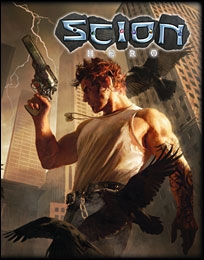Onyx Path’s Month of Nightmares features games, stories, and more to celebrate the spirit of Halloween. Count down the days with us by reading our excerpts, participating in the discussion, or by taking advantage of our special offers leading up to a haunted Halloween.
 Off the coast of Ireland are four city-islands: Murias, Falias, Gorias and Findias. You won’t find them on any map, but the same waters that lap against the Emerald Isle’s shore lap against theirs. If you find the way to these places, you’ll see shattered ruins and feel high magic, wild and unfettered from a time when the Tuatha were young. Search further, and you’ll find both fae and mortal, their eyes unseeing but souls weighted with knowledge, sequestered there by Gods who want to keep them from the prying eyes of the World. Not too far geographically, but infinitely far if you don’t know the way, lies the Isle of Avalon, where Arthur rests until the hour of Britain’s greatest need. There’s people on the isle, ruled by a nonet in the slumbering king’s stead. Across the World, if you’ve the right heritage and aptitude, you can climb a side of Mount Fuji and find yourself on another mountain entirely — H?rai. Some believe the scent of fruit in the air grants you knowledge and lightens your heart so you never grow old; others find it to be an interminably sad place.
Off the coast of Ireland are four city-islands: Murias, Falias, Gorias and Findias. You won’t find them on any map, but the same waters that lap against the Emerald Isle’s shore lap against theirs. If you find the way to these places, you’ll see shattered ruins and feel high magic, wild and unfettered from a time when the Tuatha were young. Search further, and you’ll find both fae and mortal, their eyes unseeing but souls weighted with knowledge, sequestered there by Gods who want to keep them from the prying eyes of the World. Not too far geographically, but infinitely far if you don’t know the way, lies the Isle of Avalon, where Arthur rests until the hour of Britain’s greatest need. There’s people on the isle, ruled by a nonet in the slumbering king’s stead. Across the World, if you’ve the right heritage and aptitude, you can climb a side of Mount Fuji and find yourself on another mountain entirely — H?rai. Some believe the scent of fruit in the air grants you knowledge and lightens your heart so you never grow old; others find it to be an interminably sad place.
Scion’s second limited-run book, Demigod, introduced the terra incognita as a setting element — places that were a part of Scion’s setting (called the World) but were technically (and mystically) separate. Early history is filled with stories of wondrous places that later were deemed fantasy. Despite copious reports of early travelers visiting them, palaces, cities, even entire islands were written off as fable and legend.
In Scion Second Edition, terra incognita are a far more ubiquitous setting element. The terra incognita encompass civilizations and worlds in and of themselves, and they infinitely expand the World itself; you can even play characters originating from a terra incognita, who’ve never been to the bright (and occasionally profane) cities of the modern World. Here’s one of the older edition’s terra incognita, one that informed the way we’re handling this setting element in the new edition.
Svartalfheim
The svartalfar, twisted parodies of the alfar, shun light and the surface. Svartalfheim consists entirely of tunnels and caverns. The roots of Yggdrasil run through the earth surrounding the realm and can be used to reach Svartalfheim, as can various portals and gates constructed by the svartalfar. Powerful svartalfar warriors guard these entrances using weapons that can harm even Gods. The greatest svartalfar lords and ladies certainly devised routes into and out of Svartalfheim known only to themselves, but these routes are just as certainly guarded by devious traps, terrible beasts and dire curses.
Svartalfheim is a terra incognita—technically part of the World, but set apart from mortal knowledge. This mythic realm intersects Midgard anywhere the svartalfar choose, though the nexus always involves a tunnel or cavern far underground. The svartalfar traditionally entered the mortal World only in Northern Europe. Of late, though, the svartalfar open portals anywhere around the World a lord sees opportunities to gain power, curry favor with the Titans or simply indulge sadistic whims.
As perfected titanspawn of their dwarf cousins, the svartalfar fill their realm with wondrous artifice. Svartalfar cities consist of large caverns where great halls and dwellings are carved from the rock walls or seemingly shaped from clusters of immense stalagmites. Their dwellings often feature high ceilings and large spaces. Seemingly impossible wonders, such as vast automated sculptures and gardens of edible gold and gems, showcase their greatness and power. Extensive mines and quarries supply raw materials for their wondrous items. When the svartalfar bother to supply light, it is always pale and cold, coming from either huge, glowing jewels or thin air. Much of the menial work is done by magic or clockwork servants crafted by the svartalfar. They keep slaves and captives as a show of power and cruelty rather than any real need for their labor, as there is little the svartalfar cannot achieve on their own.
The center of the realm holds the palace of King Fafnir. The palace puts even the most impressive lesser svartalfar’s home to shame. Anyone who wants to meet Fafnir on his home territory must meet him here. Though he is devious and cruel, Fafnir receives guests with opulent hospitality. Like most of his kind, he makes bargains and trades, but only when he assumes he will benefit the most—and usually as a means to lead his supplicant to destruction through a curse of treachery. Cabals of Fafnir’s subjects regularly scheme to overthrow their king, but Fafnir’s power and cunning usually results in these would-be conspirators turning against each other long before they present any danger to his rule.

Comments
4 responses to “Day 21: Terra Incognita”
Yay Underdar-I mean Stvartalfheim. Then again if its not based on a cheep Chinese toy the most of the quirks of DND as I understand actually do come form somewhere, just garbled through the rather particular source materials available during the seventies.
Raises another question. Just how much has modern pop culture affected the gods by Fatebinding. The first edition joked about it but has Thor begun to develop a few blond streaks in that red beard of his, or does Hades periodically twitch and begin sounding like James Woods, a horrifyingly situation I would expect.
Oh cool, an actual preview. I was hoping there would be more like this in October, but I guess I misread the intent.
Interesting peak, by the way.
I’d like to see dwarves and svartalfar merged into the same thing in the new edition instead of being two races, because in Norse mythology they really weren’t. Fafnir was a dwarf and the dwarf realm was full of the wonder and glory mentioned above. Some could be on the side of the Gods and others the Titans.
Not really two different races so much as two different STAGES of the same race, dwarves & svartalfar in Scion mostly are, transformed by personal legends and intents.